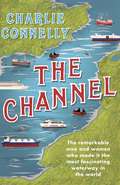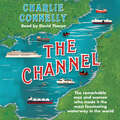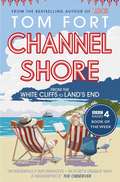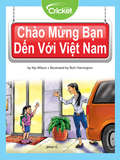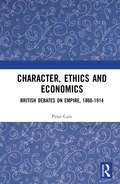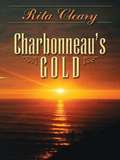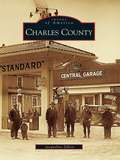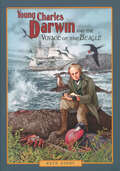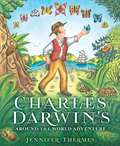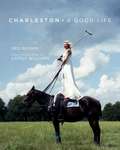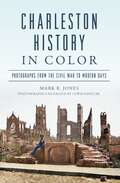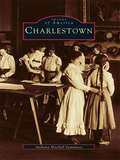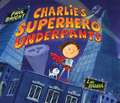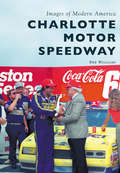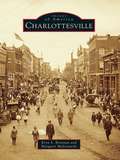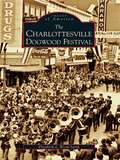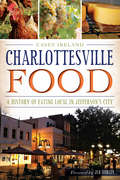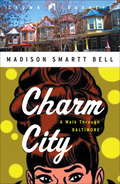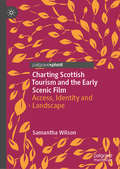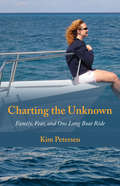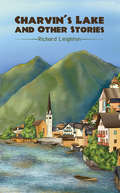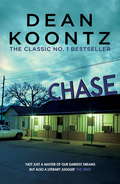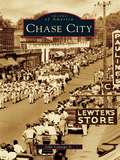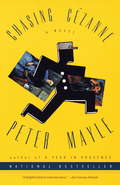- Table View
- List View
The Channel: The Remarkable Men and Women Who Made It the Most Fascinating Waterway in the World
by Charlie ConnellyA bulwark against invasion, a conduit for exchange and a challenge to be conquered, the English Channel has always been many things to many people. Today it's the busiest shipping lane in the world and hosts more than 30 million passenger crossings every year but this sliver of choppy brine, just 21 miles wide at its narrowest point, represents much more than a conductor of goods and people. Criss-crossing the Channel - not to mention regularly throwing himself into it for a bracing swim - Charlie Connelly collects its stories and brings them vividly to life, from tailing Oscar Wilde's shadow through the dark streets of Dieppe to unearthing Britain's first beauty pageant at the end of Folkestone pier (it was won by a bloke called Wally). We learn that Louis Bleriot was actually a terrible pilot, the tragic fate of the first successful Channel swimmer, and that if a man with a buttered head and pigs' bladders attached to his trousers hadn't fought off an attack by dogfish we might never have had a Channel Tunnel. Here is a cast of extraordinary characters - geniuses, cheats, dreamers, charlatans, visionaries, eccentrics and at least one pair of naked, cuddling balloonists - whose stories are all united by the English Channel to ensure the sea that makes us an island will never be the same again.
The Channel: The Remarkable Men and Women Who Made It the Most Fascinating Waterway in the World
by Charlie Connelly'A wonderfully quirky history' SUNDAY TIMES'The perfect read while you wait for your summer holiday to begin' MAIL ON SUNDAY'Quippy anecdotes are woven with historical reference and geographical context to give full colour' IRISH TIMESA bulwark against invasion, a conduit for exchange and a challenge to be conquered, the English Channel - 21 miles wide at its narrowest point - represents much more than a conductor of goods and people. Criss-crossing the Channel, Charlie Connelly collects its stories and brings them vividly to life, from tailing Oscar Wilde's shadow through the dark streets of Dieppe to unearthing Britain's first beauty pageant at the end of Folkestone pier. We learn that Louis Bleriot was actually a terrible pilot, the tragic fate of the first successful Channel swimmer, and that if a man with a buttered head and pigs' bladders attached to his trousers hadn't fought off an attack by dogfish we might never have had a Channel Tunnel.Charlie Connelly uncovers remarkable tales of swimmers and flyers, pirates and soldiers, heroes and villains, pioneers and refugees. Their stories are all united by the English Channel to ensure the sea that makes us an island will never be the same again.
Channel Shore
by Tom FortThe English Channel is the busiest waterway in the world. Ferries steam back and forth, trains thunder through the tunnel. The narrow sea has been crucial to our development and prosperity. It helps define our notion of Englishness, as an island people, a nation of seafarers. It is also our nearest, dearest playground where people have sought sun, sin and bracing breezes. Tom Fort takes us on a fascinating, discursive journey from east to west, to find out what this stretch of water means to us and what is so special about the English seaside, that edge between land and seawater. He dips his toe into Sandgate's waters, takes the air in Hastings and Bexhill, chews whelks in Brighton, builds a sandcastle in Sandbanks, sunbathes in sunny Sidmouth, catches prawns off the slipway at Salcombe and hunts a shark off Looe. Stories of smugglers and shipwreck robbers, of beachcombers and samphire gatherers, gold diggers and fossil hunters abound.
Chào Mừng Bạn Dến Với Việt Nam
by Kip WilsonA young girl and her parents visit the foreign country of Vietnam. While exploring Ho Chi Minh City, the girl's parents test her knowledge of the Vietnamese language, including "hello," "please," "thank you," and "goodbye."
Character, Ethics and Economics: British Debates on Empire, 1860-1914
by Peter CainThis book is an examination of the concept of ‘character’ as a moral marker in the later nineteenth and early twentieth centuries. Its main purpose is to investigate how the ‘character talk’ that helped to shape elite Britons’ sense of themselves was used at this time to convince audiences, both in Britain and in the places they had conquered, that empire could be morally as well as materially justified and was a great force for good in the world. A small group of radical thinkers questioned many of the arguments of the imperialists but found it difficult to escape entirely from the sense of moral superiority that marked the latter’s language.
Charbonneau's Gold: A Lewis & Clark Story
by Rita ClearyThe hardships were incredible. The duration of the trip overland and over the Rockies was much longer than expected. Some hope arrived with Charbonneau, who claimed he knew the way to the Pacific
Charles County
by Jacqueline ZillioxFaithful subjects of the English crown, Jesuits, and entrepreneurs first settled in Charles County in the early 1630s. The area quickly sprouted into Colonial-styled plantation life of distinct Southern charm. The currency of the day was tobacco, even for payment of taxes and doctor bills. Through the War of 1812 and the Civil War, the mainly agricultural economy of the county was devastated. But as time passed, plantations became farmsteads, Native American trails became roadways, and the railroad created new town centers, such as Waldorf and La Plata. In the earlier years, the county's self-sufficiency was strongly displayed when the public school system and fire departments were started through private donations. For most of its life, Charles County's only employer not associated with agriculture was the Indian Head Naval Proving Ground, now known as the Indian Head Division, Naval Surface Warfare Center. It is still ranked as the county's number one employer. Tobacco still reigned as the cash crop of choice until 2000.
Charles Darwin and the Voyage of the Beagle
by Ruth AshbyIn 1831, young adventurer and nature enthusiast Charles Darwin set sail on a remarkable five-year voyage that changed the study of biology forever.Award-winning author Ruth Ashby shares the story of Darwin's famous journey aboard the British navy ship, the Beagle, which led to the development of his theories of evolution and natural selection.This lively account follows the naturalist's exciting trip around the world—through seasickness, a life-threatening illness, and even an earthquake—as he explores South America, the Cape Verde Islands, Tahiti, and the Galapagos Islands. During his travels, Darwin meets Indigenous peoples and carefully collects and catalogs plants, fossils, birds, mammals, and insects. Darwin's observations of the distribution and diversity of plant and animal life ultimately leads to the development of his theories on evolution.Readers will be inspired by Darwin's transformation from talented but mediocre schoolboy into a remarkable scientist as they read about the revolutionary voyage that forever changed the world of biology.
Charles Darwin's Around The World Adventure
by Jennifer ThermesIn 1831, Charles Darwin embarked on his first voyage. Though he was a scientist by profession, he was an explorer at heart. While journeying around South America for the first time aboard a ninety-foot-long ship named the Beagle, Charles collected insets, dug up bones, galloped with gauchos, encountered volcanoes and earthquakes, and even ate armadillo for breakfast! The discoveries he made during this adventure would later inspire ideas that changed how we see the world. <p><p> Complete with mesmerizing map work that charts Darwin's thrilling five-year voyage, as well as "Fun Facts" and more, Charles Darwin's Around-the-World Adventure captures the beauty and mystery of nature with wide-eyed wonder.
Charles Kuralt's America
by Charles KuraltCharles Kurault takes a year-long trip across the United States, visiting well-known and out-of-the-way places alike. He describes the things he sees, the people he meets and his thoughts on it all.
Charleston: A Good Life
by Ned Brown Gately WillamsInspired by the legendary work of Slim Aarons, a photographic narrative tour of a beautiful, unique, historical city and the remarkable people who live there.Author Ned Brown kicks off the Good Life series with the story about what makes Charleston, South Carolina so desirable to its residents and the five million visitors who seek it out each year. This stunning coffee- table book features photographs by Gately Williams, whose work is regularly featured in Garden & Gun, Coastal Living, and other publications.With his signature ease, Brown profiles more than fifty “interesting Charlestonians, doing interesting things in a beautiful place.” Charleston: A Good Life highlights native Charlestonians and those who have made the southern Holy City their home during the past two decades. Some are wealthy, many not, but all enjoy the richness of a place that has been voted the best small city in the world by Travel + Leisure magazine.
Charleston History in Color: Photographs from the Civil War to Modern Days
by Lewis Hayes Mark R. JonesCharleston Like It's Never Been Seen Hand-colored, vivid details bring these historic photographs to life like never before. Witness the beginnings of the sweetgrass basket tradition. See the bleak devastation on Meeting Street after the Civil War. Note intense contrast in blues and grays of prisoners captured at the Battle of Bull Run. Explore the Battery as it looked in the 1800s. And dazzle in the bright fashions of flappers at the dawn of "the Charleston" dance craze. Author Mark Jones and artist Lewis Hayes bring a new vision to Holy City history.
Charlestown (Images of America)
by Anthony Mitchell SammarcoOriginally settled in 1629, Charlestown became well-known as the scene of the pivotal Revolutionary Battle of Bunker Hill, actually fought on Breed's Hill. Recovering from a devastating fire at the hands of the British soon after the battle, Charlestown went on to become a prosperous neighbor to Boston, eventually being annexed to the larger city in 1874. Today the city is enjoying a tremendous rebirth and the restoration of many of its important landmarks, such as the 1780 Warren Tavern.
Charlie's Superhero Underpants
by Paul BrightOn a wild and windy day all the laundry blows away. Socks and shirts, a woolly hat, and--far worse than all of that--is Charlie's Superhero Underpants! Disaster! Charlie sets off around the world to find them. He discovers a fine French fox wearing Sophie's socks, and he finds a pair of llamas wearing brother Ben's pajamas . . . but WHO'S got Charlie's Superhero Underpants?
Charlotte Motor Speedway: From Granite To Gold (Images of Modern America)
by Deb WilliamsWhen Charlotte Motor Speedway opened in June 1960, the track built by Bruton Smith and Curtis Turner became a cornerstone in the decade that launched NASCAR’s superspeedway era. Stock car racing’s first paved 1.5-mile track immediately grabbed the motorsports world’s attention with the young sport’s longest event—a 600-mile race. And the track never left the spotlight, despite struggling through several years of bankruptcy. After regaining control of his beloved track in 1975, Smith, along with former speedway general manager H.A. “Humpy” Wheeler and current president Marcus Smith, transformed the facility into a groundbreaking showplace with trackside condominiums, a 16,000-square-foot high-definition television screen, the luxurious Speedway Club, VIP suites, stadium seating, and the first superspeedway in NASCAR’s modern era to host night racing. The historic speedway has always been a favorite with Hollywood filmmakers and in recent years has expanded into a multiuse motorsports facility.
Charlottesville
by Eryn S. Brennan Margaret MaliszewskiNestled in the foothills of the Blue Ridge Mountains, the city of Charlottesville thrives amidst numerous tangible reminders of an incredibly rich history. Founded in 1762, the heart of early Charlottesville was the stage for some of the most important figures in early American history, including Thomas Jefferson, James Madison, and James Monroe. Growing side by side with Jefferson's University of Virginia, Charlottesville developed into a bustling community whose businesses, families, and celebrations were well documented in photographs beginning in the 1880s. The collection of images reproduced in Images of America: Charlottesville tells the story of the creation, growth, hardship, transformation, and success of a city beloved by residents and visitors alike.
Charlottesville Dogwood Festival, The (Images of America)
by Elizabeth D. SmithDuring the month of April, the residents of Albemarle, Buckingham, Fluvanna, Greene, Louisa, Madison, Nelson, and Orange Counties converge on the city of Charlottesville to celebrate the beauty of Central Virginia and honor the state flower. Beginning in 1950 as the Apple Harvest Festival, the festival took on its current name, the Charlottesville Dogwood Festival, in 1958. Each year, Charlottesville comes alive not only with the blooms and blossoms of spring, but with fireworks, amusement rides, and a host of local royalty. The beauty of the Blue Ridge Mountains and fall foliage as well as breathtaking springs and some of the nation's oldest and most prestigious plantations make this area one of the most popular places to visit in the South. The Charlottesville Dogwood Festival takes pride in being a long-standing part of an area rich in tradition and heritage.
Charlottesville Food: A History of Eating Local in Jefferson's City (American Palate)
by Casey IrelandFrom the early days of Thomas Jefferson's "Garden Book" at Monticello to the hustle and bustle of the modern City Market on Water Street, Charlottesville has an illustrious culinary history. The city's cuisine is characterized by a delight in locally raised ingredients. The locavore mentality appears at all levels of Charlottesville's food industry, including the nationally acknowledged methods of Joel Salatin's Polyface Farms, the sourcing of local pork for Chipotle's Charlottesville location and the accessibility of regional ingredients everywhere from Whole Foods Market to online favorite Relay Foods. Author and food enthusiast Casey Ireland explores how Charlottesville's residents have created a food culture that is all their own..
Charm City
by Madison Smartt BellWith a writer’s keen eye, a longtime resident’s familiarity, and his own sly wit, acclaimed novelist Madison Smartt Bell leads us on a walk through his adopted hometown of Baltimore, a city where crab cakes, Edgar Allan Poe, hair extensions, and John Waters movies somehow coexist. From its founding before the Revolutionary War to its place in popular culture—thanks to seminal films like Barry Levinson’s Diner, the television show Homicide, and bestselling books by George Pelecanos and Laura Lippman—Baltimore is America, and in Charm City, Bell brings its story to vivid life. First revealing how Baltimore received some of its nicknames—including “Charm City”—Bell sets off from his neighborhood of Cedarcroft and finds his way across the city’s crossroads, joined periodically by a host of fellow Baltimoreans. Exploring Baltimore’s prominent role in history (it was here that Washington planned the battle of Yorktown and Francis Scott Key witnessed the “bombs bursting in air”), Bell takes us to such notable spots as the Inner Harbor and Federal Hill, as well as many of the undiscovered corners that give Baltimore its distinctive character. All the while, Charm City sheds deserved light onto a sometimes overlooked, occasionally eccentric, but always charming place. From the Hardcover edition.
Charting Scottish Tourism and the Early Scenic Film: Access, Identity and Landscape
by Samantha WilsonWhat impact did walking tours and scenic films have on leisure activities? In what ways did working class travel disrupt normative narratives concerning nature and identity? The appreciation of nature and leisure travel have a complex and interrelated history in Scotland. In Charting Scottish Tourism, Wilson looks at how scenic filmmaking altered the construction of the tourist map and spatial identities at the turn of the 20th Century. Scenic film, the author argues, played a key role in the expansion of regional travel and national tourism during the period. In addition, scenic film provides the modern researcher with an unrivalled source of documentary evidence relating to the manner in which Scottish working and middle class communities explored and reclaimed the natural spaces around them. The author examines the central role of the Scottish scenic within leisure performances and the way in which these films promoted and challenged normative spatial narratives. These discursive shifts, she argues, had a wide-reaching impact on popular assumptions concerning space, nature and identity both home and away. Charting Scottish Tourism provides a fascinating case study and numerous methodological insights for students and researchers interested in documentary film as well as the construction of identity and the natural world.
Charting the Unknown
by Kim PetersenThis is Kim Petersen's memoir recounting how she and her family navigated through death of a child, facing fear of the water, personally building a sixty-five-foot power catamaran and a four thousand mile crossing of the Atlantic Ocean with her husband and two teenaged kids. It's Eat, Pray, Love on the water.
Charvin's Lake and Other Stories
by Richard LeightonAndrew Falconer was born to be Head Gardener, but he was also born to travel and meet some unlikely people along the way, but then as the saying goes, 'you can never really escape your fate'. Charvin's Lake is based on a series of lively adventures as lived by Andrew Falconer, who, whilst working in England and the South of France, unwittingly finds himself caught up in all sorts of unforeseen adventures that include intense family drama, a murder mystery, dealing with unwanted ghosts, stumbling upon an old bronze inkwell that seems to possess strong supernatural powers and the restoration of an ancient park with more than a few surprises. In spite of all this, he still manages to fit in plenty of trout fishing and hiking in his spare time and does all this in the company of numerous companions who are instantly drawn to his adventurous lifestyle, as well as his natural talent for being both everywhere and everything, but certainly not for being boring.
Chase: A chilling tale of psychological suspense
by Dean KoontzA race against time... and a deadly killer. Chase is an unputdownable thriller of pacey action, suspense and a terrifying killer, from bestselling author Dean Koontz. Perfect for fans of Richard Laymon and Harlan Coben.'A master storyteller his fast-paced plots are wonderfully fiendish, taking unexpected twists and turns' - San Diego Union-TribuneBen Chase is a war hero with bitter memories. Vietnam left him with a hard drinking habit, a mental breakdown - and massive guilt.So who will believe him when he swears a psychopath is out to get him? When society is sick, the mad are sane - and persecution is a killer's game... What readers are saying about Chase: 'Great vintage Koontz, tightly plotted, full of twists and well written''A good thrilling read that kept me turning the pages to find out what happened next''Five stars'
Chase City (Images of America)
by John Caknipe Jr.The rich and vibrant history of Chase City, originally called Raine's Tavern, dates back to the mid-1700s. With its mineral springs and fertile farm and timberlands, Chase City, named for former Supreme Court justice Salmon P. Chase, has been a tourist destination since 1733 when surveyor William Byrd II dubbed the area the "Land of Eden." Depicted in this volume are the prosperous days of Thoroughbred racehorses and plantations in the 1850s to Reconstruction from 1866 to 1877. The rise, fall, and rebound of the town are traced through vintage photographs, as is the city's current status as the center for commerce and culture, and as a leader in Southside's tobacco market.
Chasing Cezanne: A Novel
by Peter MayleHanky-panky on the international art scene is the source of the hilarity and fizz in Peter Mayle's new novel. He flies us back to the south of France (a region some readers of his irresistible best-sellers believe him to have invented), on a wild chase through galleries, homes of prominent collectors, and wickedly delectable restaurants. There are stopovers in the Bahamas and England, and in New York, where that glossiest of magazines, Decorating Quarterly, reflects the cutting-edge trendiness of its editor, Camilla Jameson Porter. (Camilla has recently broken new ground in the world of power lunches by booking two tables on the same day, and shuttling between them, at the city's trendiest restaurant.)It is Camilla who has sent our hero, Andre Kelly, to Cap Ferrat to take glamorous photo-graphs of the houses and treasures of the rich, famous, and fatuous. He happens to have his camera at the ready when he spots a Cézanne being loaded onto a plumber's truck near the home of an absent collector. Odd, thinks Andre. And in no time he's on the trail of a state-of-the-art art scam, chasing Cézanne.It's a joy to follow him and the crowds intent on speeding or foiling his quest--including a beautiful agent; a super-savvy art dealer attracted to the finer things in life, especially if they promise the payoff of a lifetime; an awesome Dutch forger; some outstandingly greedy New York sophisticates; and, invisible in the background, the parade of remarkable chefs whose mouthwatering culinary masterpieces periodically soothe the hero and tantalize the reader of Chasing Cézanne.
